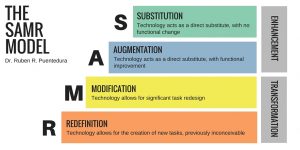
SAMR is one lens through which we can view technology integration, and “provides us with a critical framework for assessing the richness of the technology task itself” (Brooks Kirkland, 2017). As we all know in our hearts, not every teacher is using technology in transformative ways in the classroom. The Library Learning Commons model is ideal for giving teachers support and space to collaborate in enriching their use of technology, as well as modeling rich technology use. Here are some ideas about how the LLC can become a space for redefining tasks with technology:
- Westsyde Secondary in Kamloops uses LiveBinder as a classroom curation tool to gather and organize web resources (Kachel, n.d.). I’d say that this is around the augmentation stage, bringing improvements over other curation tools, but we could push it further by having students perform curation and resource evaluation collaboratively, redefining who the curator is and how they work.
- Many LLCs now encompass makerspaces. The beauty of makerspaces is that we can make our own tools that are not available off-the-shelf, or are prohibitively expensive. For example, Sandy Eix at Science World runs inspiring workshops on creating science apparatuses using Micro:bits, including a $40 spectrophotometer. “Real” spectrophotometers cost thousands. The LLC can become a hub to support both teachers and students in creating opportunities that wouldn’t exist if we didn’t invent them ourselves.
- Creative virtual LLCs are redefining how our students use our spaces. Students and teachers have opportunities to access library resources outside of school, to meaningfully interact and give feedback on library activities, and to use scaffolded, inquiry-based knowledge-building centres to explore topics of interest (Brooks Kirkland, 2015).
Works Cited:
Brooks Kirkland, A. (2015). Knowledge-Building Centres – Design for Learning: A Discovery Guide for Librarians. Retrieved April 08, 2021, from https://sites.google.com/site/bythebrooksdesignforlearning/knowledge-building-centres
Brooks Kirkland, A. (2017, May 10). Models for technology integration in the learning commons. Retrieved April 13, 2021, from https://journal.canadianschoollibraries.ca/models-for-technology-integration-in-the-learning-commons/
Kachel, A. (n.d.). Ancient civilizations – grade 8. Retrieved April 13, 2021, from http://wsslibrary.weebly.com/ancient-civilizations—grade-8.html
Lefflerd. (2016, April 3). The SAMR Model [Digital image]. Retrieved April 13, 2021, from https://commons.wikimedia.org/wiki/File:The_SAMR_Model.jpg
R, C. (Producer). (2013, May 30). SAMR in 120 seconds [Video file]. Retrieved April 13, 2021, from https://www.youtube.com/watch?v=us0w823KY0g
Thank you for bringing up the concept of makerspaces and their connection to the LLC. Having these resources can be a great way to open up opportunities for learning that would otherwise not be possible.
Your first example also caught my eye, as I like the idea of having live curation for students to have easy access to necessary resources. I wonder if having students do the curation changes the task’s position on the SAMR model?
Hi Victoria,
I think the collaboration moreso than the student-led curation piece is what transforms the task, personally. It’s one thing for a kid to make a list of resources, but for the whole class to collaborate to produce a comprehensive list is new. Although, web tools like LiveBinder have their advantages for students working alone, too.
Cheers,
Jessica
Hi Jessica,
Thank you for clarifying your idea. I appreciate that you are able to use the same piece of technology in different ways to move it from different stages in SAMR.
I appreciate the TL perspective regarding the SAMR model, as well as your concrete examples. I like how you embedded the ‘SAMR in 120 Seconds’ video, as well. Now, if only I can figure out how to do this, as well!
Hi Stacey,
Youtube actually has embed code you can copy-paste if you look under the “share” options of the video.
Cheers,
Jessica